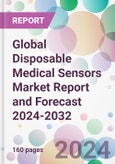Global Disposable Medical Sensors Market Outlook
The global disposable medical sensors market size was valued at USD 8.7 billion in 2023, driven by growing elderly population and the prevalence of chronic diseases have led to a higher demand for home-based medical care across the globe. The market size is anticipated to grow at a CAGR of 9.7% during the forecast period of 2024-2032 to achieve a value of USD 20 billion by 2032.Disposable Medical Sensors: Introduction
Disposable medical sensors are single-use, cost-effective devices designed to detect and monitor various health parameters. They are used in clinical settings or by patients at home for purposes like diagnosing diseases, monitoring vital signs, or managing chronic conditions. These sensors ensure hygiene, minimize infection risks, and support remote patient monitoring. Common types include biosensors, accelerometers, and temperature sensors. Their convenience and ability to provide real-time data are driving their increasing integration into the healthcare landscape.Key Trends in the Global Disposable Medical Sensors Market
The growing elderly population and the prevalence of chronic diseases have led to a higher demand for home-based medical care. Disposable medical sensors facilitate remote monitoring and management of health conditions, reducing the need for frequent hospital visits.Technological advancements have led to the development of more sophisticated disposable medical sensors with enhanced functionalities, such as improved sensitivity, specificity, and the ability to monitor multiple parameters simultaneously.
In light of global health events, there is an increased focus on infection control in healthcare settings. Disposable sensors minimize the risk of cross-contamination between patients, aligning with the stringent hygiene protocols.
There's a trend towards integrating disposable medical sensors with telehealth platforms. This integration facilitates real-time data transmission to healthcare providers, enabling timely decision-making and intervention.
While the market is growing, manufacturers must navigate complex regulatory landscapes and reimbursement policies that vary across regions, which can impact market penetration and adoption rates.
As healthcare costs continue to rise, there's an emphasis on cost-effective solutions for patient monitoring. Disposable medical sensors offer a cost-effective alternative to reusable devices, without compromising the quality of care.
Global Disposable Medical Sensors Market Segmentation
Market Breakup by Product Type
- Biosensor
- Image Sensor
- Accelerometer
- Temperature Sensors
- Others
Market Breakup by Technology
- Strip Sensor
- Wearable Sensor
- Implantable Sensor
- Invasive Sensor
- Ingestible Sensor
- Others
Market Breakup by Application
- Diagnostic
- Therapeutic
- Patient Monitoring
- Others
Market Breakup by End User
- Hospitals
- Homecare
- Diagnostic Laboratories
- Clinics
- Others
Market Breakup by Region
- North America
- Europe
- Asia Pacific
- Latin America
- Middle East and Africa
Global Disposable Medical Sensors Market Overview
In North America, the disposable medical sensors market is propelled by advanced healthcare infrastructure, a strong focus on patient safety, and technological innovation. The region leads in the adoption of remote monitoring and home healthcare, driving the demand for disposable sensors. The market benefits from substantial investments in research and development, resulting in innovative products that enhance patient care and operational efficiency in healthcare settings.Europe's market is characterized by high standards of healthcare, stringent regulatory requirements for medical devices, and a strong emphasis on infection control. The region has a growing elderly population, increasing the demand for home-based and remote monitoring solutions. Disposable medical sensors are integral to these solutions, supported by initiatives and funding from the European Union to incorporate digital health technologies and improve healthcare services.
The market in the Asia-Pacific region is rapidly growing, driven by increasing healthcare expenditure, improvements in healthcare infrastructure, and a rising awareness of advanced medical technologies. Countries like China, Japan, and India are witnessing a surge in demand for disposable medical sensors, particularly for managing chronic diseases and catering to remote and rural areas. The market's growth is further fueled by the rising prevalence of lifestyle diseases and the need for cost-effective healthcare solutions.
Global Disposable Medical Sensors Market: Competitor Landscape
The key features of the market report include patent analysis, grants analysis, clinical trials analysis, funding and investment analysis, partnerships, and collaborations analysis by the leading key players.- SSI Electronics
- ACE Medical Devices
- Sensirion AG Switzerland
- Smith’s Medical
- Koninklijke Philips N.V.
- GE Healthcare
- Analog Devices, Inc.
- Honeywell International Inc.
- TE Connectivity
- Medtronic
- NXP Semiconductor
- STMicroelectronics
- OMNIVISION
- First Sensor AG
- Ambu A/S
This product will be delivered within 5-7 business days.
Table of Contents
1 Preface
3 Global Disposable Medical Sensors Market Overview
4 Global Disposable Medical Sensors Market Landscape
5 Global Disposable Medical Sensors Market Dynamics
6 Global Disposable Medical Sensors Market Segmentation
7 North America Disposable Medical Sensors Market
8 Europe Disposable Medical Sensors Market
9 Asia Pacific Disposable Medical Sensors Market
10 Latin America Disposable Medical Sensors Market
11 Middle East and Africa Disposable Medical Sensors Market
12 Patent Analysis
13 Grants Analysis
14 Funding Analysis
15 Partnership and Collaborations Analysis
16 Regulatory Framework
17 Supplier Landscape
18 Global Disposable Medical Sensors Market - Distribution Model (Additional Insight)
20 Company Competitiveness Analysis (Additional Insight)
21 Payment Methods (Additional Insight)
Companies Mentioned
- SSI Electronics
- ACE Medical Devices
- Sensirion AG Switzerland
- Smith’s Medical
- Koninklijke Philips N.V.
- GE Healthcare
- Analog Devices Inc. Honeywell International Inc.
- TE Connectivity
- Medtronic
- NXP Semiconductor
- STMicroelectronics
- OMNIVISION
- First Sensor AG
- Ambu A/S
Methodology

LOADING...
Table Information
| Report Attribute | Details |
|---|---|
| No. of Pages | 160 |
| Published | February 2024 |
| Forecast Period | 2024 - 2032 |
| Estimated Market Value ( USD | $ 9.5 Billion |
| Forecasted Market Value ( USD | $ 20 Billion |
| Compound Annual Growth Rate | 9.7% |
| Regions Covered | Global |
| No. of Companies Mentioned | 14 |









